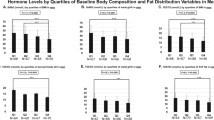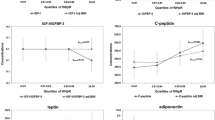Abstract
Objective
Obesity is associated with a variety of chronic diseases, including cancer, which may partly be explained by its influence on sex steroid hormone concentrations. Whether different measures of obesity, i.e., body mass index (BMI), waist circumference, and percent body fat were differentially associated with circulating levels of sex steroid hormones was examined in 1,265 men, aged 20–90+ years old, attending the morning examination session of the Third National Health and Nutrition Examination Survey (NHANES III).
Materials and methods
Serum hormones were measured by immunoassay. Weight, height, and waist circumference were measured by trained staff. Percent body fat was estimated from bioelectrical impedance. Multivariate linear regression was used to estimate associations between body fatness measures and hormone levels.
Results
Total and free testosterone and sex hormone binding globulin concentrations decreased, whereas total and free estradiol increased with increasing BMI, waist circumference, and percent body fat (all p trend < 0.05). The magnitude of change in these hormones was similar for a one-quartile increase in each body fatness measure.
Conclusion
Measured BMI, waist circumference, and percent body fat led to similar inferences about their association with hormone levels in men.
Similar content being viewed by others
References
James WPT (2008) The epidemiology of obesity: the size of the problem. J Intern Med 263:336–352
Flegal KM, Graubard BI, Williamson DF et al (2005) Excess deaths associated with underweight, overweight, and obesity. JAMA 293:1861–1867
Jee SH, Sull JW, Park J et al (2006) Body-mass index and mortality in Korean men and women. N Engl J Med 355:779–787
Pischon T, Boeing H, Hoffmann K et al (2008) General and abdominal adiposity and risk of death in Europe. N Engl J Med 359:2105–2120
Calle EE, Kaaks R (2004) Overweight, obesity and cancer: epidemiological evidence and proposed mechanisms. Nat Rev Cancer 4:579–591
Schneider G, Kirschner MA, Berkowitz R et al (1979) Increased estrogen production in obese men. J Clin Endocrinol Metab 48:633–638
Finkelstein JS, O’Dea LS, Whitcomb RW et al (1991) Sex steroid control of gonadotropin secretion in the human male. II. Effects of estradiol administration in normal and gonadotropin-releasing hormone-deficient men. J Clin Endocrinol Metab 73:621–628
Hayes FJ, Seminara SB, Decruz S et al (2000) Aromatase inhibition in the human male reveals a hypothalamic site of estrogen feedback. J Clin Endocrinol Metab 85:3027–3035
Jones TM, Fang VS, Landau RL et al (1978) Direct inhibition of leydig cell function by estradiol. J Clin Endocrinol Metab 47:1368–1373
Plymate SR, Matej LA, Jones RE et al (1988) Inhibition of sex hormone-binding globulin production in the human hepatoma (Hep G2) cell line by insulin and prolactin. J Clin Endocrinol Metab 67:460–464
Snijder MB, van Dam RM, Visser M et al (2006) What aspects of body fat are particularly hazardous and how do we measure them? Int J Epidemiol 35:83–92
National Center for Health Statistics (1994) Plan and operation of the third national health and nutrition examination survey, 1988–1994. Series 1: programs and collection procedures. Vital Health Stat 1:1–407
Sun SS, Chumlea WC, Heymsfield SB et al (2003) Development of bioelectrical impedance analysis prediction equations for body composition with the use of a multicomponent model for use in epidemiologic surveys. Am J Clin Nutr 77:331–340
Vermeulen A, Verdonck L, Kaufman JM (1999) A critical evaluation of simple methods for the estimation of free testosterone in serum. J Clin Endocrinol Metab 84:3666–3672
Rinaldi S, Geay A, Dechaud H et al (2002) Validity of free testosterone and free estradiol determinations in serum samples from postmenopausal women by theoretical calculations. Cancer Epidemiol Biomarkers Prev 11:1065–1071
Shah BV, Barnwell BG, Bieler GS (1995) SUDAAN user’s manual: software for analysis of correlated data. Research Triangle Institute, Research Triangle Park
Deurenberg P, Andreoli A, Borg P et al (2001) The validity of predicted body fat percentage from body mass index and from impedance in samples of five European populations. Eur J Clin Nutr 55:973–979
Vermeulen A, Goemaere S, Kaufman JM (1999) Testosterone, body composition and aging. J Endocrinol Invest 22:110–116
Kyle UG, Genton L, Hans D et al (2001) Age-related differences in fat-free mass, skeletal muscle, body cell mass and fat mass between 18 and 94 years. Eur J Clin Nutr 55:663–672
Ogden CL, Yanovski SZ, Carroll MD et al (2007) The epidemiology of obesity. Gastroenterology 132:2087–2102
Chan DC, Watts GF, Barrett PHR et al (2003) Waist circumference, waist–hip ratio and body mass index as predictors of adipose tissue compartments in men. QJM 96:441–447
Lean ME, Han TS, Morrison CE (1995) Waist circumference as a measure for indicating need for weight management. BMJ 311:158–161
Pasquali R, Casimirri F, Cantobelli S et al (1991) Effect of obesity and body fat distribution on sex hormones and insulin in men. Metabolism 40:101–104
Field AE, Colditz GA, Willett WC et al (1994) The relation of smoking, age, relative weight, and dietary intake to serum adrenal steroids, sex hormones, and sex hormone-binding globulin in middle-aged men. J Clin Endocrinol Metab 79:1310–1316
Couillard C, Gagnon J, Bergeron J et al (2000) Contribution of body fatness and adipose tissue distribution to the age variation in plasma steroid hormone concentrations in men: the HERITAGE family study. J Clin Endocrinol Metab 85:1026–1031
Gapstur SM, Gann PH, Kopp P et al (2002) Serum androgen concentrations in young men: a longitudinal analysis of associations with age, obesity, and race. The CARDIA male hormone study. Cancer Epidemiol Biomarkers Prev 11:1041–1047
Svartberg J, Midtby M, Bonaa KH et al (2003) The associations of age, lifestyle factors and chronic disease with testosterone in men: the tromso Study. Eur J Endocrinol 149:145–152
Travison TG, Araujo AB, Kupelian V et al (2007) The relative contributions of aging, health, and lifestyle factors to serum testosterone decline in men. J Clin Endocrinol Metab 92:549–555
Shiels MS, Rohrmann S, Menke A et al (2009) Association of cigarette smoking, alcohol consumption, and physical activity with sex steroid hormone levels in US men. Cancer Causes Control 20:877–886
Vermeulen A, Kaufman JM, Giagulli VA (1996) Influence of some biological indexes on sex hormone-binding globulin and androgen levels in aging or obese males. J Clin Endocrinol Metab 81:1821–1826
Muller M, den Tonkelaar I, Thijssen JH et al (2003) Endogenous sex hormones in men aged 40–80 years. Eur J Endocrinol 149:583–589
Abate N, Haffner SM, Garg A et al (2002) Sex steroid hormones, upper body obesity, and insulin resistance. J Clin Endocrinol Metab 87:4522–4527
Ukkola O, Gagnon J, Rankinen T et al (2001) Age, body mass index, race and other determinants of steroid hormone variability: the HERITAGE Family Study. Eur J Endocrinol 145:1–9
Hsieh C–C, Signorello LB, Lipworth L et al (1998) Predictors of sex hormone levels among the elderly: a study in Greece. J Clin Epidemiol 51:837–841
Wu AH, Whittemore AS, Kolonel LN et al (1995) Serum androgens and sex hormone-binding globulins in relation to lifestyle factors in older African–American, white, and Asian men in the US and Canada. Cancer Epidemiol Biomarkers Prev 4:735–741
Wu AH, Whittemore AS, Kolonel LN et al (2001) Lifestyle determinants of 5 alpha-reductase metabolites in older African–American, white, and Asian–American men. Cancer Epidemiol Biomarkers Prev 10:533–538
Suzuki R, Allen N, Appleby P et al (2009) Lifestyle factors and serum androgens among 636 middle aged men from seven countries in the European prospective investigation into cancer and nutrition (EPIC). Cancer Causes Control 20:811–821
Tchernof A, Labrie F, Belanger A et al (1997) Androstane-3{alpha}, 17{beta}-diol glucuronide as a steroid correlate of visceral obesity in men. J Clin Endocrinol Metab 82:1528–1534
Acknowledgments
This is the eighth paper from the Hormone Demonstration Program funded by the Maryland Cigarette Restitution Fund at Johns Hopkins. Drs. Shiels, Lopez, and Joshu were supported by the National Institutes of Health National Research Service Award (T32 CA009314). We thank Gary Bradwin in Dr. Rifai’s laboratory.
Author information
Authors and Affiliations
Corresponding author
Rights and permissions
About this article
Cite this article
Rohrmann, S., Shiels, M.S., Lopez, D.S. et al. Body fatness and sex steroid hormone concentrations in US men: results from NHANES III. Cancer Causes Control 22, 1141–1151 (2011). https://doi.org/10.1007/s10552-011-9790-z
Received:
Accepted:
Published:
Issue Date:
DOI: https://doi.org/10.1007/s10552-011-9790-z




